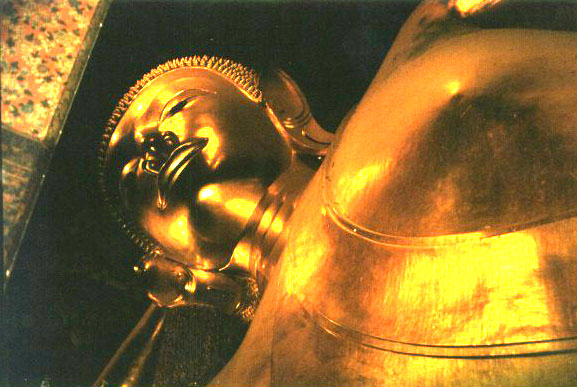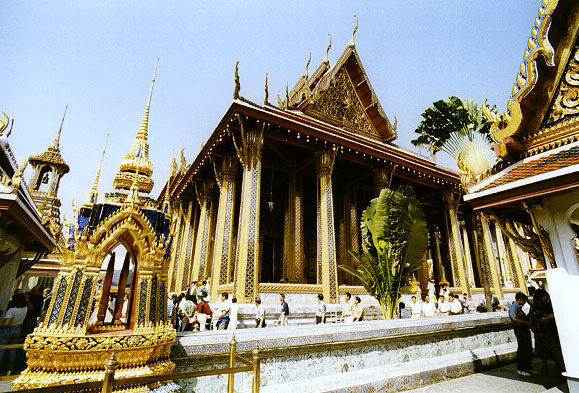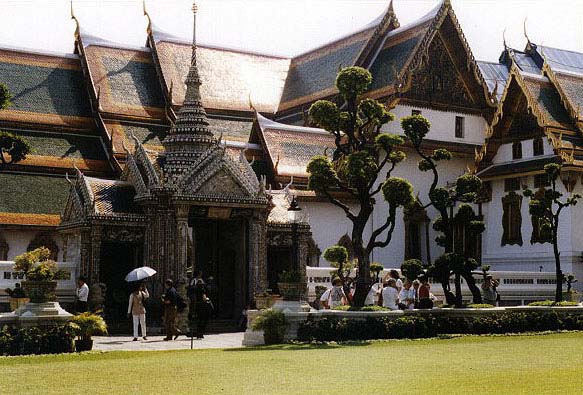 |
| Royal residence and gardens, the Grand Palace |
Just south of Wat Phra Kaew we visited the gardens of the royal palace residence. The residence and the grand halls adjacent to it have not been the actual living residence of the king for some years now, yet they are still used for coronations, official ceremonies and the interment of royal ashes. At the center of the garden is Chakri Mahaprasat, the Great Holy Hall of Chakri. Built in 1882 by British architects, the hall combines an odd, yet successful blend of Thai, Victorian and Italian Renaissance architecture. Something about it harkened back to images of the great halls of Amsterdam or Brussels, but it still possessed a certain flair that was uniquely Thai. The tourists certainly seemed to eat it up.
We paused for a brief snack of prepackaged Haagen Dasz imported from New Jersey. We then continued north to Wat Mahathat, Thailand's premiere house of Buddhist learning. While Wat Mahathat is centered around a sim like other wats, its grounds extend for several acres in the form of tree-lined alleys and hidden passageways, all home to students, monks and some local families as well. It was a serene neighborhood surrounded by the anarchic din of Bangkok traffic. While I enjoyed the peace and quiet it provided, I felt that at some level we were intruding here, despite the friendliness of its residents. Eventually we left the campus and continued east into the heart of Bangkok.
It was now close to 11am and the heat was bearing down on us. After walking for ten minutes or so, Susanne wisely suggested we catch a tuk-tuk - Thailand's answer to India's three-wheeled motorized autorickshaws - and proceed to another wat. So we flagged down the next available tuk-tuk and roared through town to Wat Suthat, a medium size monastery that boasts one of the largest surviving Sukhothai-style bronze Buddhas, known for its thin face and sinewy fingers. The wat itself was modest compared to others we had seen this morning, yet at that particular time there was a prayer service inside, with one monk leading a group of 30 or so women in a solemn chant. I sat quietly on the floor and listened to the hypnotic drone. I captured some of the chanting on my tape recorder, though I left my camera inside my bag - it seemed a little rude to whip it out at this particular moment. The tape recorder at least allow for a more subtle approach to capturing the event.
We left Wat Suthat and turned south along a tree-lined parkway. Our next stop was Pahurat, a series of markets and neighborhoods that included Indiantown and Chinatown. The markets first appeared as a series of stalls running parallel to each side of the street. We were in the textiles and garment district - everything the cheapest of face towels to the finest silk suits could be had here for the right amount of baht.
The market street terminated at a busy intersection. But the Chinatown bazaar was supposed to continue through the next block - where was it? A crowd of people covered the other side of the street, but as they moved across the intersection it became clear that the street did indeed continue up ahead, in the form of a thin alleyway that was no wider than a car's width across. This was gonna be tight.
We joined the hordes of shoppers and moved into the alley. It was wall-to-wall people - you couldn't avoid having another person touching and pressing into you at all times. A pickpocket's paradise, I thought. In order to move deeper into the bazaar, you had no choice but to go with the flow - quite literally. Pushing and shoving made no difference here, so we let the human wave carry us forward. Inside the bazaar it was hot, humid and roaring with the cacophony of shoppers and sellers. The vendors added to the din with their various noisemakers, including alarm clocks, cellular pagers, boomboxes blaring Thai pop, Indian dance music, even Aqua's now-ubiquitous "Barbie Girl" song. I bet the noise gave sellers the upper hand when bargaining - it was too loud to think so I'm sure it was damn near impossible to haggle with a clear head.
The market continued block after block for about a kilometer. Shoppers swarmed in all directions while the occasional beggar lay on the ground, wailing for alms, as nearly everyone stepped over them without even acknowledging their presence. (These beggars, I should note, were truly few and far between in Bangkok. I'd see more homeless people on my walk to work in DC than I'd see in a full day in Bangkok.) We pressed through the bazaar for half an hour until I started to feel a bit light headed. The air was hot and sticky and I hadn't fully adjusted to Bangkok time, so we paused at the next major intersection to rest with a couple bottles of Coke.
My thirst quenched, I was ready to get up and go. But as we tried to continue east, the bazaar's traffic thinned out back to an average street - whoops, we were lost. The LP guide contained a map of Pahurat and the market areas, but we had reached a neighborhood where none of the streets were labeled in English. I wondered if we were supposed to have turned left back where we bought the sodas. Not knowing exactly where we were, I suggested we walk north until we reached a major intersection. After a block or two we reached an impressive wat - a landmark on the map, I hoped. I looked at the map and saw a wat that was in the general vicinity of where I thought we were, but this wat was closed to the public, and the wat listed in the book was supposed to be a major tourist attraction. We walked its perimeter just to see if we could get inside and ask someone directions (I was eager to see if I remembered how to say left, right, and straight ahead in Thai) but all the doors were locked shut. Getting rather frustrated, we continued our walk north. Soon, I saw a sign that said "Hotel Chinatown." Aha! I was positive this place was in the book. I checked our guide and found the hotel listed on the map. Now we knew where we were; great news, but the map also proved that were now standing in the middle of nowhere. Time to hire another tuk-tuk.
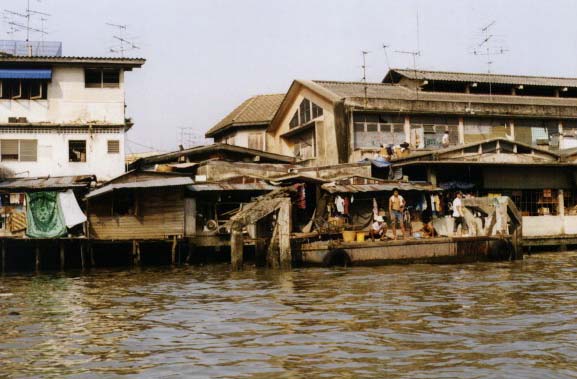 |
| A view of Bangkok from the Chao Praya Express |
We returned to the hotel for a quick Coke and crossed the street to Tha Phra Athit, the local canal dock for the Chao Praya River Express boats. For six baht each - about 15 cents - we caught the next express ferry heading south. We weren't going anywhere in particular, just a little maritime joyride. The ferry was crowded with local commuters and a few farang tourists with their cameras and sunglasses. I wondered if we stood out as badly as the rest of them. Susanne and I managed to find a seat, so we got comfortable and enjoyed the ride down the canal. Despite the noise of the motor, Bangkok seemed so much more peaceful from the water's perspective. Sampans and ferries came and went from one dock to the next, but as a whole the water traffic was light, especially compared to the street congestion just a few yards onshore. On the left I could see the Grand Palace in the distance, with Wat Pho's chedis not too far above it. And to the right we caught our first glimpse of Wat Arun, perhaps the city's most recognized landmark. It's the tallest wat in Bangkok, and its increasingly thinning stupa reminded me of a solid stone Eiffel Tower. Unfortunately, Wat Arun was covered in scaffolding, so it wasn't exactly the awesome site you might expect. But as the universal symbol of Bangkok, it served as yet another reminder that we indeed in the heart of southeast Asia.
reminded me of a solid stone Eiffel Tower. Unfortunately, Wat Arun was covered in scaffolding, so it wasn't exactly the awesome site you might expect. But as the universal symbol of Bangkok, it served as yet another reminder that we indeed in the heart of southeast Asia.
We neared the southern end of the express ferry route, so I suggested we get off the boat and check out the Oriental Hotel. Along with Hong Kong's Peninsula Hotel and the Raffles in Singapore, the Oriental is regarded as one of the finest hotels in Asia. Ever the aficionado of colonial-era hotels, I wanted to take a look. The hotel was awashed in white - white walls, white staircases, white uniforms. It felt like an overexposed black and white photograph, or a scene from some Stanley Kubrick film. We sat for a while in the Author's Cafe, formerly a favorite haunt of Graham Greene and other globetrotting writers of the past. The cafe, also completely white, shone brightly from numerous skylights on the ceiling. A large red and white staircase circled downward in two directions, not unlike something you might find in an antebellum southern mansion. We ordered tea and scones and ate while two young Thai men in (white) tuxedos played flute and guitar. To our dismay, they performed poor interpretations of western songs like "Don't Cry for Me Argentina" and "Yesterday" at a pace slow enough to put asleep even the most wired of standup comics. Some visitors might call this place heaven, but after a short time it began to feel like hell in whitewash. Longing for the noise of the city, we polished off our teas and departed, pausing long enough to take advantage of the sparkling clean serenity of the hotel restrooms.
It was early evening rush hour on the Chao Praya Express, but again we managed to find some seats. Susanne soon got up and stood along the side of the boat to take some pictures. I joined her eventually and admired the view as the wake of our boat crashed below me. We reached our dock and jumped off the boat as dozens of commuters and uniformed school kids crossed on and off the ferry. Somehow it was now past 5pm and I was thoroughly exhausted, so we headed to the room for a rest. Earlier we had talked about seeing a Thai kickboxing match that night but I bitterly opposed moving myself off the bed. After some successful cajoling on Susanne's part, though, I agreed to go to a match.
Muay Thai, or Thai boxing, is the national pastime of Thailand. In Bangkok fights take place in either the Lumphini Boxing Stadium or the Ratchadamnoen Stadium, depending on what day of the week it is. Tonight, Thursday Night at the Fights would be at Ratchadamnoen. We caught a tuk-tuk near Khao San Road for the quick ride north up Ratchadamnoen Avenue to the boxing stadium. Several hundred Thais of all ages were hanging out in front of the arena, enjoying what appeared to be a festive tailgate party. We approached a ticket counter; I knew seats started around 150 baht per person, so I asked the woman at the counter, "Thaorai Baht?" - "How much?" I had gotten pretty good at understanding numbers in Thai, but with all of the crowd noise, I couldn't decipher her response. Looking rather embarrassed that she couldn't communicate with me, she stepped back and brought over her supervisor, who gazed at me, taking his index finger and pointing it upward. Isn't that a rude gesture in Thailand?, I thought. But I looked up and over the ticket window I saw in large print the number 210. Oh, 210 baht. So I handed her our 420 baht - a total of ten dollars, give or take - and purchased our second class tickets for some seats upstairs.
Susanne and I climbed the concrete stairs to get to the upper deck. Inside we found an arena in the round, with bleacher seats for our balcony level and ringside chairs below us in the first class level. In the center of the arena was the ring itself, about 30 feet square. Two tiny, thin boxers were in the ring, kneeling on the mat in prayer while their trainers prayed with them from their respective corners. In the first class seats sat a well dressed audience, talking among themselves and laughing. But in second class, it was an entirely different story: hundreds of men of all ages were standing around, waving their hands and fingers while shouting out numbers at the top of their lungs. The match would begin in under two minutes according to the clock, and people were placing their final bets. If Muay Thai was Thailand's number one pastime, placing bets on Muay Thai probably held a close second. With all the commotion, I was reminded distinctly of commodities trading at the Chicago Mercantile exchange. The shouting, the hand signaling, even the cellular phones going off - the denizens of second class had business to do, and time was running out.
The first match began with a familiar "ding" of a bell. A quartet of two drummers, a flutist and a cymbalist hammered out a continuous tribal beat, making the fight all the more exotic. The two boxers circled each other slowly, punching and kicking when the opportunity revealed itself. Each swing or kick that connected with its target scored a certain number of points, and whoever had the highest total at the end of the match would be declared the winner.
Initially, the two fighters fought rather limply, so we paid more attention to our fellow audience members instead. I noticed that our balcony level was screened in with chicken wire, like the Thunderdome in the Mad Max film - was this for the boxer's protection or ours? A large Thai man with an old knife scar wrapped across his face like a thin mustache shouted out bets during the breaks between each round. I could hear him yell, "Haa sip! Haa sip!" - "50 baht! 50 baht!" The bets would rise as the bell for the next round approached. With ten seconds before the bell, the man hollered, "Gao sip, gao sip! Roi Roi! Roi saam sip!" - "90, 90! 100, 100! 130!!!" The bell rang, the match resumed, and our scar-faced neighbor pulled out his cell phone in an apparent attempt to check voice mail. There were also a few Thai women who took part in arranging bets, sometimes more vigorously than men. In the audience I could only count a handful of westerners, yet none of the Thais seemed to pay attention to our presence. I know that may sound like an odd comment, since clearly no one would care if a couple of Thai tourists attended a boxing match in Vegas. But I considered my frame of reference: if this match had taken place in India, we would have been hounded constantly. Here, though, we were just another face in the crowd, and I took much comfort in that fact.
My gaze returned to the fight, and suddenly, Wham! One fighter leveled a stunning right foot kick into the jaw of his opponent. Sweat and blood sprayed across the mat as this poor fellow fell flat on his back, knocked out cold. His trainer tried to revive him as the audience screamed and booed. Large wads of baht were exchanged between the winners and losers. After a minute or two the trainers pulled a stretcher into the ring and carried away the downed unconscious fighter in abject defeat.
The next fight was more evenly matched, lasting a full five rounds until one boxer won in an 11-7 decision. Once again, thick handfuls of 100, 500 and even 1000 baht notes were exchanged throughout the audience. The third match started soon after 8pm. It didn't seem to be much of a fight, so we returned to the hotel by tuk-tuk halfway through the third round. Nothing like an evening of Muay Thai to wrap up a busy day in Bangkok.
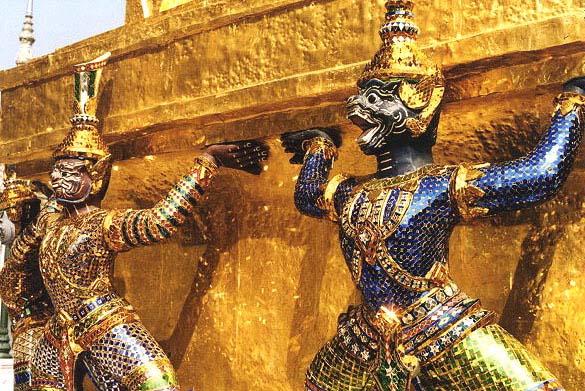
 of Bangkok, famous throughout Southeast Asia. We began our day with a walk south past the Grand Palace to Wat Pho, the largest and oldest temple in Bangkok. The Palace didn't open until 8:30am, so Wat Pho seemed a natural first stop. Technically, the monastery opened to the public at 8am, but when we arrived around 8:05, there was no sign of any staff to collect our entry fee of 20 baht
of Bangkok, famous throughout Southeast Asia. We began our day with a walk south past the Grand Palace to Wat Pho, the largest and oldest temple in Bangkok. The Palace didn't open until 8:30am, so Wat Pho seemed a natural first stop. Technically, the monastery opened to the public at 8am, but when we arrived around 8:05, there was no sign of any staff to collect our entry fee of 20 baht each. So we strolled through the open gate and made ourselves at home (we'd pay as soon as we saw the ticket collector, of course - I promise...)
each. So we strolled through the open gate and made ourselves at home (we'd pay as soon as we saw the ticket collector, of course - I promise...)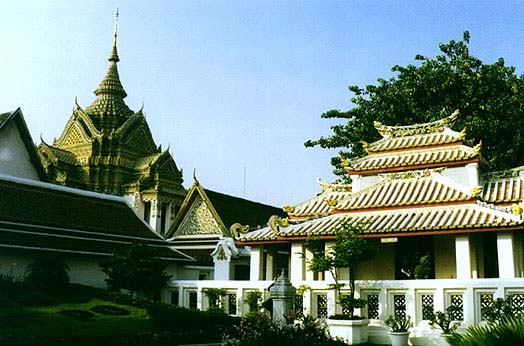
 reminiscent of turn-of-the-century B&W photos I had once seen of Sri Lanka. Apart from a handful of monks and the resident cats and dogs, we had the wat to ourselves. The silence and serenity made the moment all the more glorious. We wandered through the gardens, marveling at the sun's rays dancing off the chedis and the dozens of stone Buddhas swathed in saffron-dyed robes. Susanne headed off on her own in one direction while I entered one of the wat's major sims - central temples used as houses of worship. Inside I found a massive bronze Buddha coated in gold foil, surrounded by several dozen candles and incense sticks. A lone monk encouraged me to enter and take pictures, so I took off my shoes outside and came in for a closer look. I was somewhat surprised that photography was allowed in here, but the monk smiled and raised his hands in the shape of a camera in front of his face and again waved me closer to get the shot.
reminiscent of turn-of-the-century B&W photos I had once seen of Sri Lanka. Apart from a handful of monks and the resident cats and dogs, we had the wat to ourselves. The silence and serenity made the moment all the more glorious. We wandered through the gardens, marveling at the sun's rays dancing off the chedis and the dozens of stone Buddhas swathed in saffron-dyed robes. Susanne headed off on her own in one direction while I entered one of the wat's major sims - central temples used as houses of worship. Inside I found a massive bronze Buddha coated in gold foil, surrounded by several dozen candles and incense sticks. A lone monk encouraged me to enter and take pictures, so I took off my shoes outside and came in for a closer look. I was somewhat surprised that photography was allowed in here, but the monk smiled and raised his hands in the shape of a camera in front of his face and again waved me closer to get the shot.  . Once again we removed our shoes and entered the temple, this time to find a gargantuan golden Buddha, 46 meters long and 15 meters high. I had never seen anything like it before. Susanne commented how there was no chance our cameras could ever capture the sheer size of this graceful being, so we focused less on taking pictures and more on appreciating the moment - it's not like there are any convenient giant reclining Buddhas back in DC for us to visit.
. Once again we removed our shoes and entered the temple, this time to find a gargantuan golden Buddha, 46 meters long and 15 meters high. I had never seen anything like it before. Susanne commented how there was no chance our cameras could ever capture the sheer size of this graceful being, so we focused less on taking pictures and more on appreciating the moment - it's not like there are any convenient giant reclining Buddhas back in DC for us to visit. 